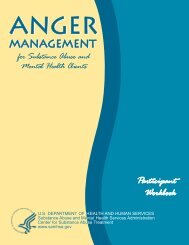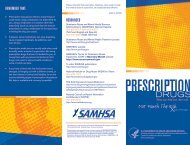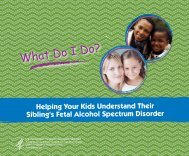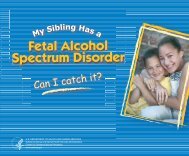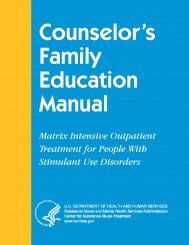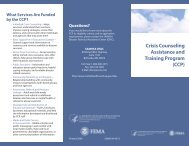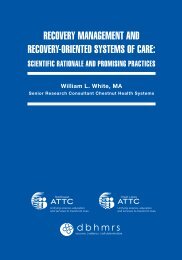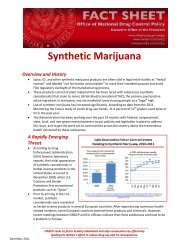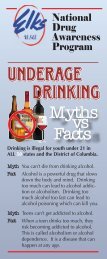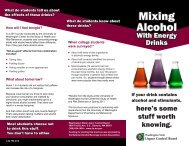Counselor's Manual for Relapse Prevention With Chemically ...
Counselor's Manual for Relapse Prevention With Chemically ...
Counselor's Manual for Relapse Prevention With Chemically ...
You also want an ePaper? Increase the reach of your titles
YUMPU automatically turns print PDFs into web optimized ePapers that Google loves.
Unstabilized relapse-prone patients have not been taught to identify the abstinence-basedsymptoms of PAW and addictive preoccupation. Treatment fails to provide these patients withthe skills necessary to interrupt their disease progression and stop using alcohol and drugs. As aresult, they are unable to adhere to a recovery program requiring abstinence, treatment, andlifestyle change.Stabilized relapse-prone patients recognize that they are chemically dependent, need to maintainabstinence to recover, and need to maintain an ongoing recovery program to stay abstinent. Theyusually attend Alcoholics Anonymous (AA), Narcotics Anonymous (NA), or another 12-stepprogram in addition to receiving ongoing professional treatment. They also make protractedef<strong>for</strong>ts at psychological and physical rehabilitation and recommended lifestyle changes duringabstinence. However, despite their ef<strong>for</strong>ts, these people develop symptoms of dysfunction thateventually lead them back to alcohol or drug use.Many counselors mistakenly believe that most relapse-prone patients are not motivated torecover. Clinical experience has not supported this belief. More than 80 percent of relapse-pronepatients admitted to the relapse prevention program at Father Martin's Ashley in Havre de Grace,Maryland, had a history of both recognition of their chemical addiction and motivation to followaftercare recommendations at time of discharge. In spite of this, they were unable to maintainabstinence and sought treatment in a specialized relapse prevention program. he or she becameaware of during this exercise.Part II: <strong>Relapse</strong> <strong>Prevention</strong> TreatmentChapter 4—What Is <strong>Relapse</strong> <strong>Prevention</strong> Treatment?<strong>Relapse</strong> prevention is a systematic method of teaching recovering patients to recognize andmanage relapse warning signs. <strong>Relapse</strong> prevention becomes the primary focus <strong>for</strong> patients whoare unable to maintain abstinence from alcohol or drugs despite primary treatment.Recovery is defined as abstinence plus a full return to bio/psycho/social functioning. Aspreviously noted, relapse is defined as the process of becoming dysfunctional in recovery, whichleads to a return to chemical use, physical or emotional collapse, or suicide. <strong>Relapse</strong> episodes areusually preceded by a series of observable warning signs. Typically, relapse progresses frombio/psycho/social stability through a period of progressively increasing distress that leads tophysical or emotional collapse. The symptoms intensify unless the individual turns to the use ofalcohol or drugs <strong>for</strong> relief.To understand the progression of warning signs, it is important to look at the dynamic interactionbetween the recovery and relapse processes. Recovery and relapse can be described as relatedprocesses that unfold in six stages:Abstaining from alcohol and other drugsSeparating from people, places, and things that promote the use of alcohol or drugs, andestablishing a social network that supports recovery



